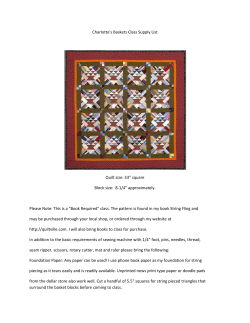
Document 280132
Technical Briefs summarize findings that are of interest to a relatively limited audience. Readers desiring fuller details may obtain them by writing directly to the author(s) at the address given or, if this is impossible for any reason, to the Editorial Office of this journal. hypothyroidism who was being treated ment gave the following results: TSH, England) We find that glycine is eluted in large amounts from test strips used to detect the presence of ketones in urine (“Ketur-Test”; Boehringer Corp., Lewes, U.K.). Immersion of the strip for 1 s (the time recommended by the manufacturer) in 1 mL of water gave a glycine concentration of approximately 400 pmol/L and for 2 s approximately 1400 zmol/L when measured in an ion-exchange amino acid analyzer (Huger Analytical, Margate, U.K.). A similar increase in glycine was found for another brand of test strips (“Ketostix”; Ames Division, Miles Labs., Slough, U.K.), but this is not reported because a change in the formulation of these strips has removed the problem. Addition of glycine in these amounts would significantly increase the apparent endogenous glycine in urine samples screened by amino acid chromatography, suggesting such inherited metabolic diseases as non-ketotic hyperglycinemia and some organic acidurias. A nonspecific increase in urinary glycine may also occur for various reasons. Moderate unexplained increases in glycine in samples sent to us for amino acid screening are found relatively frequently; how many of these are ascribable to test strip contamination is unknown. Further investigation of false-positive screening tests consumes time and resources, particularly when reference is made to a specialist center. In addition to glycine, the possibility that samples might be contaminated by other test strip constituents such as organic acid buffers should be considered. Aliquots of samples tested with test strips should be discarded. replace- Sample date TSH, Sample Contamination by Test Strips, J. M. Rattenbury and Joyce C. Allen (Dept. of Chemical Pathology, Children’s Hospital, Western Bank, Sheffield SlO 2TH, by thyroxin EAIA, milli-int.units/L milli-int.units/L 11/84 5/85 7/85 8/85 4.5 19.8 9.0 16.0 9.1 18.7 22.2 Incubation of sample with Protein A-Sepharose or calf intestinal alkaline phosphatase to remove or inhibit possible immunoglobulin interferents had no effect on the discrepant results. In both assays, sample dilution gave a linear response. Furthermore, the EAIA assay buffer contains mouse serum (10 mL/L) to counter any nonspecific anti-mouse immunoglobulin reactivity, and an increase in the concentration of this component had no effect. The patient gave a positive test result for anti-mitochondrial antibodies but negative for rheumatoid factor, the latter a potential interferent in two-site immunoassays. In previous studies (1) no interference by autoantibodies in the EAJA was seen. Incubation of sample (8/85) with goat antiserum to human 1gM and subsequent assay with EAIA decreased the measured TSH to 8.0 milli-int. units/L. A further serum sample (5/86), assayed for TSH with the unmodified EAJA, gave a value of 21.5 milli-int. unitsfL; in an EAJA incorporating a modified enzyme-antibody conjugate (Fab’ fragment conjugated to alkaline phosphatase) it gave 6.6 milli-int. unitsfL; and with Fab’ fragment and sample pretreatment with anti-IgM it gave 8.6 milli-int. units/L. These results suggest that the discrepant result is ascribable to the presence of an 1gM that is cross linking the two mouse monoclonal antibodies in the standard EAJA. The 1gM is not rheumatoid factor. The binding of the 1gM appears to be through the Fc position of the monoclonal antibody, because removal of this region in the preparation of an Fab’ fragment conjugate removes the discrepant result. The EAIA will be modified by including a suitable conjugate. Interfering antibodies should be considered in cases where biochemical results are inconsistent with the clinical state of the patient. Reference 1. Clark PMS, Price CP. Enzyme-amplified and David H. Ellis (I.Q. (Bio) Ltd., Milton Road, Cambridge, U.K.) an Infant on Soy Formula, M. H. Cheng, W. Y. Huang, 414 CLINICALCHEMISTRY, Vol. 33, No. 3, 1987 of thyrotropin a new Clin Chem ultrasensitive 1986;32:88-92. Recently we reported (1) some discrepant results between an “in-house” immunoradiometric assay (xius) for thyrotropin (TSH) in serum and an enzyme-amplified irnmunoassay (z&) kit (I.Q. (Bio) Ltd., Cambridge, U.K.). In both assays, mouse monoclonal antibodies are used, the label in the EAIA being alkaline phosphatase (EC 3.1.3.1) derived from calf intestine. Serum sampled from a patient with primary assay immunoassay: Removal of Interference by lmmunoglobulins in an Enzyme-Amplified Immunoassay for Thyrotropin in Serum, Penelope M. S. Clark, Christopher P. Price (Dept. of Clin. Biochem., Addenbrooke’s Hospital, Cambridge, U.K.), 14.0 Detection of Bromocriptine-like evaluated. Substances in Urine of and A. I. Lipsey (Clinical Laboratories, Childrens Hospital of Los Angeles, Los Angeles, CA 90027) A urine specimen was submitted to our laboratory for toxicology screen to rule out possible toxin ingestion in a two-month-old infant brought to the hospital emergency room for acute gastroenteritis, diarrhea, and dehydration. The parent had a history of drug abuse, and the presence of phencyclidine (PCP) and cocaine was suspected in this
© Copyright 2025















